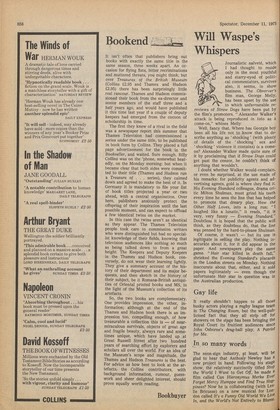Bookend
It isn't often that publishers bring out books with exactly the same title in the same season, three weeks apart. An occasion for flying fists, bitter recriminations and muttered threats, you might think; but over Treasures of the British Museum (Collins E2.95 and Thames and Hudson £2.95) there has been surprisingly little real rancour. Thames and Hudson commissioned their book from the ex-director and senior members of the staff three and a half years ago, and would have published it this time last year if a couple of deputy keepers had emerged from the cocoon of scholarship in time.
The first they knew of a rival in the field was a newspaper report this summer that Thames Television had commissioned a series under the same title, to be published in book form by Collins. They placed a full page advertisement for the book in the Bookseller, and waited. Sure enough, Billy Collins was on the 'phone, somewhat heatedly, on the Monday morning: but when it became clear that both sides were committed to their title (Thames and Hudson run a Treasure of . . . series), they calmed down and agreed to make the best of it. In Germany it is mandatory to file your list of book titles projected a year or two ahead, with a central organisation. Over here, publishers anxiously protect the offspring of their inspiration until the last possible moment, and can expect to offload a few identical twins on the market.
In this case the twins aren't as identical as they appear. The Thames Television people took care to commission writers who were distinguished but had no specialist knowledge of their fields, knowing that television audiences like nothing so much as being talked down to from a great height. The Keepers and Deputy Keepers in the Thames and Hudson book, conversely, do not wear their learning lightly. They give a summary account of the history of their department and its major bequests, and then sketch in the history of their subject, be it Romano-British antiquities of Oriental printed books and MS, in the light of the Museum's collection of its artefacts.
So, the two books are complementary. One provides impression, the other, information; although at the end of the Thames and Hudson book there is an impression too, compelling enough, of how treasurable a collection this is — of nearmiraculous survivals, objects of great age and fragile beauty, always rare and sometimes unique, which have landed up at Great Russell Street after two hundred years of searching effort by explorers and scholars all over the world. For an idea of the Museum's scope and magnitude, the Thames and Hudson Treasures is the best. For advice as how best to look at the artefacts, the Collins contributors, with background information, rumour, guesswork and sheer delighted interest, should prove equally worth reading.
Bookbuyer










































 Previous page
Previous page